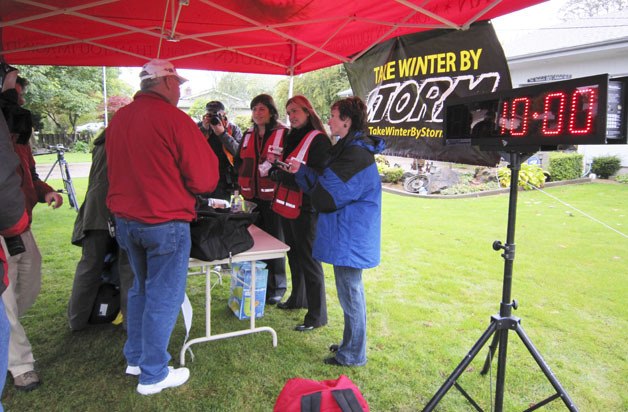If the nearby Green River were to swell and envelop his Auburn neighborhood this uncertain storm season, Phil Lercher would be more than ready.
Perhaps even more so than the average Joe, the veteran firefighter understands the importance of emergency preparedness, especially now in the face of a likely La Niña winter season. Meteorologists forecast a nasty stream of colder, wetter and snowier conditions this year.
Lercher is taking no chances. He volunteered to become a victim or more precisely, a mobilizing resident, of a “Take Winter by Storm” (TWBS) safety campaign exercise this week.
The TWBS, established in 1998, is a public awareness campaign designed to help families prepare for a hard winter and the threat of floodwaters. The $240,000 program campaign is a collaborative effort among King County, the City of Seattle, Puget Sound Energy and State Farm. The City of Auburn is a partner in the effort.
Lercher and his neighbor, Wayne Osborne, were given 10 minutes to evacuate their homes along Fourth Place Northeast. The mock evacuation brought out the best in the families, who grabbed basic survival supplies and other essentials to save them from a paralyzing flood.
Red Cross volunteers timed and evaluated the families on their evacuation skills.
Told to pack enough supplies for three days, the families generally passed the test against the clock before TV cameras in the teeth of a blustery Monday morning. The exercise also gave them ways to improve their steps.
“I’ve always wanted my kit reviewed. I’ve always wondered what should be in there, and now I’ve got some better ideas,” said Lercher, looking down at his 30-pound backpack of basic supplies.
Lercher, a Maple Valley firefighter, shares a rambler with his wife and some visiting international students. His home rests a couple of blocks from the Green River. Down his street, just a block away, is a posted rain gauge, which measures the river level. On Monday it was 54 feet, not a threatening height.
To prepare for the worse, Lercher has stocked his home with extra propane tanks in case of a power outage, and additional water in the event of a disastrous flood.
His pre-positioned backpack is always ready, filled with food, clothing, water purifiers and filters, matches, a compass, a First-Aid kit and other emergency supplies, including radios.
A sleeping bag, tent and hatchet accompany his backpack.
What he didn’t grab during the mock evac were medications and copies of important documents. Precious time did not allow him to grab family photos and other valuables.
The drill reinforced confidence in his readiness.
Lercher is an exception. Two recent USA surveys show that while 68 percent of residents saw or heard messages last year about winter weather preparedness, only 38 percent were more prepared for the 2009-2010 winter compared to the previous year. These results indicate that although more people are aware of the need to prepare for winter storms, many still have done nothing to prepare.
The TWBS campaign hopes to bring the situation to light.
“Preparedness is one of the absolute most important things that individuals can do to make sure that adverse weather conditions, including floods, don’t affect them,” said Doug Williams, spokesman for King County Department of Natural Resources and Parks. “This effort is intended to make sure everyone is aware of the dangers that flooding, especially wintertime flooding, can bring on to their families.
“And we are expecting a pretty rough winter. We expect a lot of rain and nasty storms,” he said. “The message here is preparedness.”
====
PREPARATION TIPS
• Assemble several emergency kits with a radio, flashlight, extra batteries, First-Aid kit, fire extinguisher, and three days of non-perishable food and drinking water. Store a kit at home, at work and in your car.
• Stay away from floodwaters. Play it safe and stay out of low-lying areas during times of heavy rains. If your basement is prone to flooding, stay out of the basement until the risk of flooding has passed.
• Never drive through standing water or on streets that have been closed because of flooding. Driving around a “road closed” sign is the number-one cause of death during a flood.
• Keep storm drains clear to prevent flooding. Don’t put grass clippings, leaves or other debris into drains, ditches, creeks, culverts, gutters or ravines (it’s against the law). If you live at the base of a hill or on a cliff, ensure that drainage and retaining walls are in good shape. Preventive planting can also help reduce the chance of a mudslide or flooding.
• Maintain gutters and downspouts. Twice a year, clean your gutters and the drainage downspouts attached to your roof. Direct flows from downspouts away from your home, without discharging flows to adjacent properties.
• Get snow route information for driving and transit in advance of roads being closed.
• Establish an out-of-area contact for family members to call should the local phone system be out of service.
• Review your insurance coverage regularly with your agent to identify needs and gaps. Make sure you have the appropriate policies for flood or endorsements for losses like back-up of sewers and drains, which are not covered in a standard homeowner’s policy.
• Take the time to compile a home inventory, including a detailed list of your possessions with receipts, descriptions, and—if possible—photos. Keep the inventory in a safe deposit box or other safe location away from your home.
• Store heirlooms and priceless family photographs on upper floors where they will be safer from flood waters.
• For information about how to prepare for bad weather and what to do when storms do come our way, as well as links to resources with information about road and pass conditions, transit now plans, and flooding conditions in the Puget Sound area, visit www.takewinterbystorm.org.



